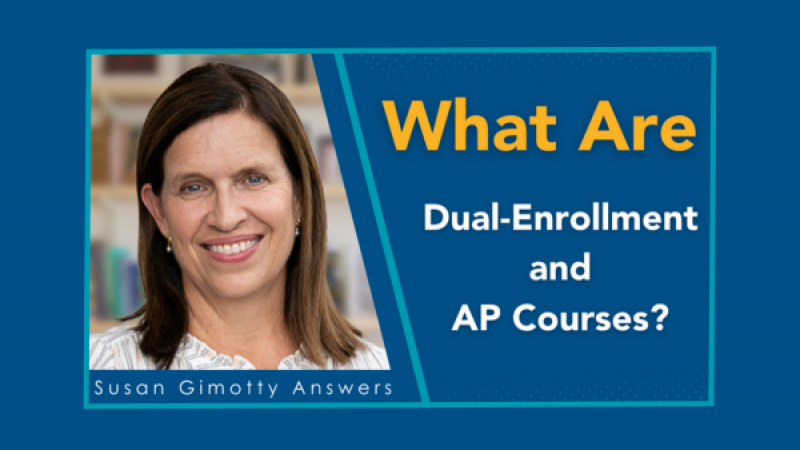Dual Enrollment & Advanced Placement (AP) | The Nitty Gritty of Homeschooling High School

Transcription
Note: This transcription may vary from the words used in the original video for better readability.
The next thing you're going to see is we offer a lot of dual-enrollment credit classes. So you see this in her [daughter’s] junior and senior year. She has DE or dual enrollment by many of her classes.
What is dual enrollment?
Dual enrollment means you take a high school class, you pay a little extra fee, and you get high school and college credit for it. It's a big deal, and it's worth understanding. And this is where your advisor can help out and help you with how to do the dual enrollment, what that looks like, etc.
You do not have to be in our Diploma Program to take a class dual enrollment. You just instead of paying an extra fee, you pay kind of an extra-extra fee because you're not in our diploma program. But let's say you want to take calculus, and you want to get dual enrollment credit. You can pay the fee, and you can get that dual enrollment credit.
Notice you also have extracurriculars here. Colleges like to see that you did more than just study and you have your ACT/SAT scores. AP, whatever you decide to choose. So this is your basic transcript. And if you start with us in ninth grade, we will start this transcript for you in ninth grade. And we just keep adding and adding and adding to it.
Today I spent about half of my day emailing my upcoming seniors their transcripts with a lot of information and asking them to double-check them. Do you want to add anything? And so we will be ready to help send that out come September when my seniors start applying for college.
So the next thing I want to talk about is the dual enrollment. I mentioned it, what is dual enrollment? Taking a high school credit, paying a little extra fee, and getting college credit also for it. So how does it work? That's how it works.
What are the advantages of dual enrollment?
Well, here's the advantage. Look at this. This Veritas course is called Rhetoric II. That's basically like a speech class. Our Rhetoric II comes in as Com 101 speech class through Cairn University in Lancaster, Pennsylvania.
That is the university we partner with is Cairn in Lancaster, Pennsylvania. Nearly every kid in college in their major has to take Speech 101 or Oral Comm, whatever they call it. So if you're savvy, you could take Rhetoric II in high school with us, pay the extra fee, fill out the form, and also get college credit.
So then, when little Sally goes to college, she does not have to take Speech 101 in college. Magic! The next one is Senior Thesis, another very popular dual enrollment class because, look, it comes in as English 101. You find me a degree plans sheet out there for a college that doesn't have to take some type of English 101.
So if you're going to take it in high school, you pay the extra fee, and then you also get college credit.
What DE courses are the best?
Those two [talked about above] are my favorite because I consider those round pegs in round holes. Another one that I like is U.S. Government. A lot of kids have to take U.S. Government in college, and so why not get rid of it and take it in high school?
Now I'm spending 5 minutes on dual enrollment. But we spend hours on seminars. This is our advantage to be in a diploma that you would get access to these our seminars, that we walk you through exactly how to make dual enrollment work for your child. So all three of my college kids took dual enrollment here at Veritas, and all three of them took about 30 hours of college credit into their degree program.
Now, let me tell you what they used it for. My three kids used it for very, very different things. We're going to go back to this photo. Michael right here took 33 hours to be exact. He knew he wanted to be a dentist, but he also knew that he wanted some business experience, and he wanted to be a finance major in addition to a pre-med major.
How in the world could you be a pre-med major and a finance major, two of the hardest majors at a university, The only way you could do that and get through in four years is to bring a lot of dual enrollment in. So he didn't have to take speech at his university. He didn't have to take English 101 at his university. He didn't take statistics. Statistics is a big one. If you're going to have to read a chart or a graph in your profession, you're going to have to take statistics in college. Statistics is hard in college, so why not take it in high school and be done with it?
Madison, over here. Remember I told you she's my teacher and she also has a Spanish minor. Elementary education is a jam-packed four-year degree with no room for a minor. What did she do with her enrollment? She used it to create some extra space in her schedule to get her Spanish minor.
Nicholas, I told you already, He's my engineer and golfer. And the golf coach tells us routinely that he is the first and hopefully only engineering major who's also a golfer. Many collegiate athletes in the NCAA – They will not even let you be a STEM major and be a college athlete. So we convinced the golf coach that we can make this work. Why? Because of his dual enrollment. So instead of taking like 16 hours each semester, Nick only has to take about 12 or 13. Yes, they are hard courses, but there are fewer. And so he can be successful in his major and on the golf course.
Another possibility for dual enrollment is to simply shave a whole year off college. I've seen it done many times and you might say, “Well, I only want to go to college for three years.” Fine. That's not what my kids did, but that is one more way to use it.
How Dual Enrollment Looks on Your Transcript
So how will it look like on my transcript? Let's look at this slide. So when you apply to college, assuming you are a diploma student, we will submit your attached transcript. That's right here. Then you will request your Cairn transcript, which is right here. And the university that your student decides to go to. This is my Nicholas, my son, who's at Oklahoma, Christian.They will merge those two together, and then it'll become your new transcript.
And so then all of these classes down here are from his Cairn transcript. And then all of these classes right here. Actually, I have that wrong. Sorry. Little small for my eyes. Let's do it the opposite way. These classes are all from Cairn. Straight off this transcript. These classes are his new classes that he took last fall.
So that's what it looks like when applying to college. If you're not a diploma student, then yours would be your own transcript, not ours. And then you get your own Cairn transcript which anybody can get, assuming you're taking dual enrollment, and then they will merge it together.
ADVANCED PLACEMENT
All right. Advanced Placement. Let's throw out another nitty-gritty of homeschooling high schoolers. You hear this a lot. What does it mean? Advanced placement. AP stands for Advanced Placement.
Why Veritas Only Offers Four AP Courses
Not a lot. You might as well. Why? Here's why. An AP course is fine, but if you don't pass the AP test with a 3 or 4, then your AP course is not as valuable because you cannot get credit to transfer out of like your calc. one– if you didn't get a three or four on the AP test.
We say if you take these classes, we will get you kind of ready for the AP test, but you will also have to study on your own. So let's say you take physics with us and you want to try to go pass the physics AP test. Well, we'll give you a lot of knowledge, and then you're going to have to go buy one of those super fat books on Amazon, probably called How to Get Ready for the AP Physics Test and study, and then hopefully be able to pass the test.
So let's look at that. You're going to earn the credits by taking the College Board AP exams, which are at the end of the year in May. You do that on your own once you're ready. You can score between a 1-5e and usually 3, sometimes 4 is considered passing. That is how AP works. So why do we have both? Why don't we have more? What do we like better, etc.
This is a little bit more your decision, but dual enrollment are guaranteed– assuming you pass the class are guaranteed credits. AP is not because you have to take that additional test. That is the biggest difference, and that's why my kids didn't do AP because I wanted the guarantee of the college credit.
Okay, Now dual enrollment doesn't always transfer to exactly what you want. That's a story for another day when you could listen to a whole-hour seminar that we do on dual enrollment. But both show that your student is ready for college level work, and that is huge. And if you're trying to get into the Harvard out there, then an AP is going to help you show rigor for very selective colleges if you can score a 4 or a 5 on the AP exam.
FAQ: CLEP, AP, and Dupal Enrollment are really, really great ways to earn college credit. The biggest differences with Dual Enrollment is you’re taking the class, and you're guaranteed to have that college credit. Now, the question is, will it be accepted at the school?
Same thing won't come for CELP. It’s just like with AP. You're going to have to study for that exam.
You also have to look at the cutoff score there on a score up to like 80. A lot of times the scores that are cutoffs are around 50 or so for some of these subjects, especially at some of your tougher schools. So you have to look at it to see if that going to be a good fit for your student
The same goes for AP. You're going to have to study for that exam separately. Even if you're taking the AP class, you're going over the content. There are very set exam strategies that you're going to have to be prepared for. So hopefully that helps.







